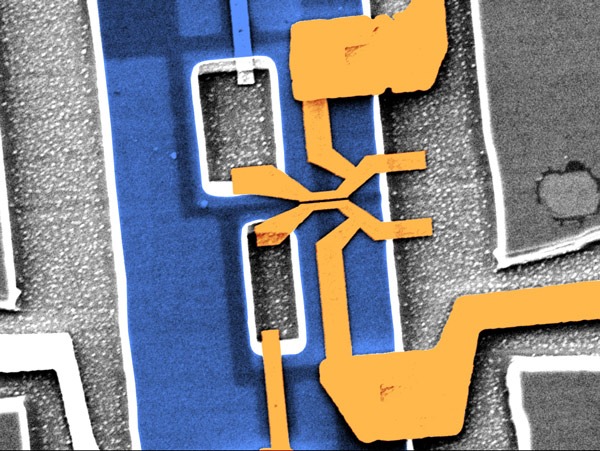Nov. 27, 2023 Research Highlight Physics / Astronomy
Using Josephson junctions to control the flow of a supercurrent
The superconducting equivalent of the diode has been realized using Josephson junctions, opening new possibilities for harnessing superconductivity in devices

Figure 1: Scanning electron microscopy image of the device, which uses two Josephson junctions to control the supercurrent flowing through one to the other. From Ref. 1. Reproduced with permission from SNCSC
RIKEN physicists have created a superconducting diode—a device that allows a supercurrent to flow in one direction but not the other1. While not the first time that such a device has been realized, this demonstration presents a new method for achieving it.
Superconductors, which allow electrical currents to flow without resistance, hold out exciting possibilities for electronics. That’s because superconducting circuits and devices promise to harness a wide range of exotic phenomenon that aren’t possible in conventional semiconductor-based devices. For example, they could be used as the basic building blocks of quantum computers.
One of the most important components in conventional silicon-based electronics is the diode—a device that lets current flow in one direction but not in the other.
An analogous concept, the superconducting diode effect also exists where the electrical resistance depends on which way the current is flowing. This effect was first demonstrated in 2020 by a group at Kyoto University and has subsequently been realized by many other groups.
Now, Sadashige Matsuo of the RIKEN Center for Emergent Matter Science and his co-workers have demonstrated the superconducting diode effect in a new way—by using two devices known as Josephson junctions (Fig. 1). In particular, they were able to use one junction to control the flow of a supercurrent in the other.
Josephson junctions consist of a thin film of a non-superconducting material sandwiched between two superconductors. Up to some critical current, electrons can cross the barrier without resistance in what is known as a supercurrent. Above the critical current, a conventional current can flow.
The key to realizing the superconducting diode effect was breaking symmetries in the device. “Symmetries, both those in space and time, in a superconducting device require that the critical currents in the two flow directions be the same,” explains Matsuo. “By breaking these symmetries, the critical current in one direction can be different from one in the other direction.” This is the superconducting diode effect.
Matsuo and team started by covering a thin but high-quality layer, known as a quantum well, of the semiconductor indium arsenide with a film of aluminum. On this platform, they then constructed two Josephson junctions that shared one superconducting electrode.
At a very low temperature, the team showed that phase control of one of the coupled junctions can break the time-reversal and spatial-inversion symmetries in the other junction.
The results provide a practical method for harnessing superconducting on a scalable electronic platform. “The next step is to use our coupled Josephson junctions to explore other exotic superconducting phenomena,” says Matsuo.
Related contents
- Connecting distant silicon qubits for scaling up quantum computers
- Single-electron devices could manage heat flow in electronic components
- Device splits and recombines superconducting electron pairs
Rate this article
Reference
- 1. Matsuo, S., Imoto, T., Yokoyama, T., Sato, Y., Lindemann, T., Gronin, S., Gardner, G. C., Manfra, M. J. & Tarucha, S. Josephson diode effect derived from short-range coherent coupling. Nature Physics 19, 1636–1641 (2023). doi: 10.1038/s41567-023-02144-x
